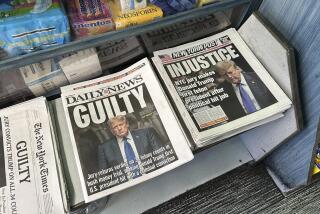Wartime Propaganda Is a Powerful Weapon
- Share via
Since Martin Luther exploited the then-new printing press to spread Protestantism across 16th century Europe, the science of technology and the art of persuasion have been inseparable. Nowhere is the marriage more apparent--or insidious--than during warfare.
As U.S. and British forces attack targets in Afghanistan, spin meisters from all sides recognize that propaganda in this conflict is a mix of old and new, from sophisticated Web sites to radio broadcasts to food rations dropped from bombers.
Different technologies aim at different audiences. Computers are scarce in Afghanistan, so Web sites primarily serve residents in more developed countries with an interest in the fighting. Within Afghanistan, information travels by radio or literally falls from the sky.
“In Afghanistan, you have extremely advanced bombers and jet fighters delivering leaflets to a population that is largely illiterate,” said Christopher Simpson, a professor of communications at American University in Washington, D.C.
Simpson and others who study the relationship between technology and propaganda note that wartime information has become a weapon every bit as powerful as the most sophisticated missile. They also agree that propaganda in this conflict is more diffuse than in the past, in part because the rise of user-friendly technologies such as the Internet and mobile phones makes it more difficult for governments to monopolize the message reaching their citizens, allies and enemies.
“The wide-open character of the Web means that the old distinctions between white and black and gray propaganda have completely broken down,” Simpson said.
The Internet demonstrated its power during the NATO bombardment of Kosovo in 1999 as residents published personal accounts online, sometimes disputing the official versions of events.
Until World War II, the printing press remained the primary piece of propaganda technology. American revolutionaries used the press to make their case for independence at the end of the 18th century. And the American government printed thousands of posters during World War I, urging citizens to “Beat Back the Hun” by buying war bonds.
During World War II, though, the radio was embraced by all sides. Japan’s Tokyo Rose was a familiar voice to soldiers in the Pacific. Today, the Voice of America remains a powerful tool to spread American values and viewpoints around the globe. Even then, though, radio was not traditionally intended to deliver mass messages.
“Studies show that after World War II, the people who listened to shortwave were the more educated people who might have some effect on government activities,” said professor James Danowski, who teaches a class that examines propaganda at the University of Illinois in Chicago. “It was not a mass kind of audience.
“There were exceptions in some countries where there was no alternative to shortwave. Radio Free Europe and other services would directly target a country. But for the most part, the audience for shortwave was rather narrow.”
With the rise of television over the “last couple of decades, the U.S. government started to take a different approach,” Danowski said. “It would provide prepackaged video feeds that would be given to broadcasters in countries to get the U.S. point of view across. That way it would go out to a much wider audience on commercial and other stations.”
Unlike printing, radio or even television, modern communications technology does not require a press or a studio. With a satellite phone and a laptop, anyone anywhere can deliver his or her spin to the world. Even with the Afghan capital, Kabul, under bombardment, it’s possible to get a phone call through for a perspective from ground zero.
Despite that diversity of viewpoints, most people tend to focus on those sources that closely match their own beliefs.
“The promise of the Internet was that it would expand the diversity of voices,” Danowski said. “But studies have shown that after an initial period, the user tends to over time habitually go to the same sites for information. They don’t look as much to the more diverse sites. It’s like TV--the bigger Web sites get bigger and the smaller ones seem to get smaller.”
That freedom to ignore other perspectives may end up being the most effective piece of propaganda in Afghanistan, some suggested. If the United States and its allies work to rebuild Afghanistan after the bombing, they might consider supplying the technological infrastructure to give residents access to the world’s media as part of a more open democracy, said Nancy Snow, associate director of UCLA’s Center for Communication and Community and author of “Propaganda, Inc.”
“If we really want to [push] the rest of the world to our way of thinking ... then we need to propagandize that message,” Snow said. “And one of the most effective ways to do that is to show a diversity of opinion.”
*
Christine Frey and David Colker cover personal technology. Frey can be reached at christine.frey@latimes.com. Colker can be reached at david.colker@latimes.com.
More to Read
Sign up for Essential California
The most important California stories and recommendations in your inbox every morning.
You may occasionally receive promotional content from the Los Angeles Times.














